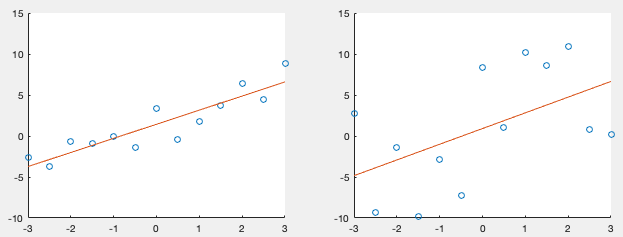Next: t-Test for Linear Regression Up: StatisticTests Previous: Two-Way (Factorial) ANOVA
The method of regression can be used to model the relationship
between an independent variable 






![$\displaystyle \varepsilon=\frac{1}{2}\sum_{i=1}^N r_i^2
=\frac{1}{2}\sum_{i=1}^N (y_i-\hat{y}_i)^2
=\frac{1}{2}\sum_{i=1}^N[y_i-(w_0+w_1\,x_i)]^2
$](img252.svg) (65)
(65)
 is the residual
of the ith data pair, assumed to be an i.i.d. sample of a normal
distribution
is the residual
of the ith data pair, assumed to be an i.i.d. sample of a normal
distribution
 .
To find the optimal coefficients
.
To find the optimal coefficients  and
and  that minimize the
squared error
that minimize the
squared error  , we set its derivatives with respect to
, we set its derivatives with respect to
 and
and  to zero:
to zero:
 |
 |
 |
|
 |
 |
||
 |
 |
 |
|
 |
 |

 |
 |
 |
|
 |
 |
 |
|
 |
 |
 |
|
 |
 |
 |
The regression function becomes:


The univariate linear regression model considered above
can be generalized to multivariate linear regression, by
which the relationship between a dependent variable 


 (66)
(66)
 . We desire to find the
. We desire to find the  model parameters
model parameters
 so that the model fits optimally a
set of observed sample points
so that the model fits optimally a
set of observed sample points
 . Substituting the observed data into the
model we get
. Substituting the observed data into the
model we get  equations
equations
 (67)
(67)
 |
 |
![$\displaystyle \left[\begin{array}{c}\hat{y}_1\\ \vdots\\ \hat{y}_N\end{array}...
...{\bf x}_D]
\left[\begin{array}{c} w_0\\ w_1\\ \vdots\\ w_D\end{array}\right]$](img282.svg) |
|
 |
 |
![$\displaystyle {\bf w}=\left[\begin{array}{c}w_0\\ w_1\\ \vdots\\ w_D\end{array}...
...\;\;\;\;
{\bf X}=[{\bf x}_0={\bf 1},{\bf x}_1,\cdots,{\bf x}_D]_{N\times(D+1)}
$](img284.svg) (68)
(68)
 so that
so that
 , i.e.,
the observed
, i.e.,
the observed  can be expressed as a linear combination
of
can be expressed as a linear combination
of  vectors
vectors
 .
However, as this is an over determined equation system with
.
However, as this is an over determined equation system with  equations but only
equations but only  unknowns
unknowns
 ,
there does not exist an exact solution. We therefore can only
find the least square (LS) approximation that minimizes
the residual
,
there does not exist an exact solution. We therefore can only
find the least square (LS) approximation that minimizes
the residual
 , the squared
error:
, the squared
error:
 |
 |
 |
|
 |
 |
(69) |
To do so, we find its gradient (derivatives) with respect to
![${\bf w}=[w_0,w_1,\cdots,w_D]^T$](img295.svg)
 (70)
(70)
 is the
is the
 pseudo-inverse
of
pseudo-inverse
of  .
.
We further consider some properties of the solution. First, we note that
![$\displaystyle {\bf X}^T{\bf r}=\left[\begin{array}{c}{\bf x}_0^T\\
{\bf x}_1^T\\ \vdots\\ {\bf x}_D^T\end{array}\right]{\bf r}={\bf0}
$](img301.svg) (72)
(72)
![$\displaystyle {\bf x}_0^T{\bf r}=[1,\cdots,1]{\bf r}=\sum_{n=1}^N r_n=0
$](img302.svg) (73)
(73)
 residuals is zero. Now the regression
model can be written as
residuals is zero. Now the regression
model can be written as
 ,
and we have
,
and we have
 (74)
(74)
 |
 |
 |
|
 |
 |
 (75)
(75)
 (76)
(76)
 ,
,
 and
and
 are
perpendicular to vector
are
perpendicular to vector
![${\bf 1}=[1,\cdots,1]^T$](img313.svg) :
:
 |
 |
 |
|
 |
 |
 |
|
 |
 |
 |
(77) |
The fact that the residual







How well the regression model fits the observed data can be quantitatively measured based on the following sums of squares:
 (78)
(78)
 (79)
(79)
 (80)
(80)
We can show that the total sum of squares is the sum of the
explained sum of squares and the residual sum of squares:
 |
 |
 |
|
 |
 |
||
 |
 |
||
 |
 |
 (81)
(81)
 (R-squared) as a measure for the goodness of the model
as the percentage of variance explained by the model:
(R-squared) as a measure for the goodness of the model
as the percentage of variance explained by the model:
 (82)
(82)
 is large, indicating a good
fit of the model to the data.
is large, indicating a good
fit of the model to the data.
In particular, when 



 and
and  related
to each other? This question can be addressed by the
correlation coefficient defined as:
related
to each other? This question can be addressed by the
correlation coefficient defined as:
 (83)
(83)
 discussed above.
discussed above.
In fact, 

 |
 |
 |
|
 |
![$\displaystyle \sum_{n=1}^N[(y_n-\bar{y})-w_1(x_n-\bar{x})]^2
=\sum_{n=1}^N[(y_n-\bar{y})^2-2w_1(y_n-\bar{y})(x_n-\bar{x})
+w_1^2(x_n-\bar{x})^2]$](img341.svg) |
||
 |
 |
(84) |
 is large, indicating the two variables
is large, indicating the two variables  and
and  are highly correlated, then SSR is small, i.e., the error
of the model is small, therefore
are highly correlated, then SSR is small, i.e., the error
of the model is small, therefore  is large, indicating the
model is a good fit of the data.
is large, indicating the
model is a good fit of the data.
Although correlation and regression are closely related to each other, they are different in several aspects:
 and
and  are correlated will
regression analysis be meaningful.
are correlated will
regression analysis be meaningful.
 is a dependent variable, possibly
random, a function of
is a dependent variable, possibly
random, a function of  , a deterministic independent
variable. But they are treated equally (both possibly random)
in correlation.
, a deterministic independent
variable. But they are treated equally (both possibly random)
in correlation.
 , by which the given samples can be interpolated
and extrapolated; but correlation cannot.
, by which the given samples can be interpolated
and extrapolated; but correlation cannot.
Examples:
 (85)
(85)

 (86)
(86)